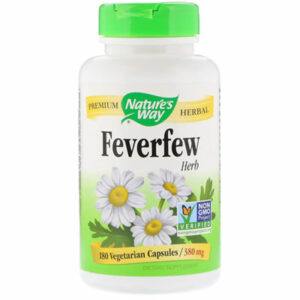Feverfew is an Asteraceae plant derived from the Balkan Peninsula in southern Europe, and its English name comes from the Latin febrifuge, which means antipyretic medicine.
It has been widely used by folk medicine for improving fever, various paints, and mosquitoes for hundreds of years. Intractable diseases such as bites and reproductive problem are also known as medieval aspirin (meaning panacea).
Do you know Feverfew benefits and side effects?
Until the past few decades, although the scientific community has not confirmed the efficacy of its antipyretic drugs, it has been further found that the main component of parthenolide (a terpene compound) has excellent anti-inflammatory effects, especially for the interference Human migraine has an improvement effect and is currently the most promising medical application.
What are the benefits of Feverfew?
1. Frequency of migraine attacks
Migraine is a periodic headache, often accompanied by nausea, sensitivity to light, and sound. It is estimated that only one in five adults in the United States has a history of migraines, and the consequences are not only headaches but also may cause nerve damage and increase the incidence of stroke and degenerative brain diseases.
Early research found that taking small white chrysanthemum (for 2 months, using 70-84 mg of dry leaf parts and filling them in capsules) can reduce the intensity and frequency of migraine attacks, and headache-related nausea and vomiting symptoms are also reduced (No change in duration).
In a recent double-blind controlled experiment (targeted at 170 people with a history of migraine for more than 20 years), it was confirmed to use the small white chrysanthemum extract (brand name MIG-99 for 16 weeks, the dose is 6.25mg three times daily) can reduce the number of migraine attacks by 39.5% (compared to 27% of placebo).
There have been previous similar experiments (for those with a lower frequency of attack) using the same formula, but no effect was found to be superior to placebo, and these two studies infer: Feverfew has a more significant effect on those with a higher attack intensity and frequency.
2. Rheumatoid arthritis
Rheumatoid arthritis is a kind of more inflammatory arthritis, which is an autoimmune disease. In the beginning, there are symptoms of arthralgia, which may be asymmetric. As the disease progresses, the symmetry of the pain will be more obvious. Most patients will have persistent joint swelling. If you do not seek medical treatment immediately, it may cause joint deformation within six months. It can cause disability, and even invade the internal organs in severe cases, causing fibrosis of organs and tissues.
Since Feverfew is believed to improve arthritis and have anti-inflammatory effects in folk therapy, a 6-week study on rheumatoid arthritis found that oral Feverfew (70-86 mg) failed to significantly improve rheumatoid Clinical symptoms of arthritis (such as stiffness, pain) and blood biochemical indicators (immunoglobulin, C-reactive protein).
3. Dermatitis
Dermatitis, as the name implies, refers to skin inflammation due to various internal and external irritation. Common ones include atopic, lipid leakage, and contact dermatitis. Common symptoms are rash and redness and swelling of the skin.
The most common drugs used to treat dermatitis are topical steroids plus oral antihistamines, and steroids are powerful anti-inflammatory drugs, but long-term use can cause side effects, which are often loved and hated.
In a dermatitis test, it was found that topical PD-Feverfew (parthenolide’s small white chrysanthemum extract) can inhibit the prostaglandin (PGE2) that causes inflammation and has the effect of relieving dermatitis, and the effect is not lost to the inflammatory drug Ibuprofen. No harmful sensitization (induced by the chemical substance methyl nicotinate).
4. Platelet aggregation, antithrombotic (may be beneficial to cardiovascular)
After entering middle age, the most feared health problem for most people is cancer, and then the occurrence of thrombosis. Thrombus generally refers to improper coagulation (formed by platelets and fibrin) in the blood, and the formed blood clot is once blocked in the crown. Arteries are myocardial infarction, if it occurs in cerebral blood vessels, it is cerebral stroke, and obstruction in other parts will cause hypoxia and necrosis of different tissues and organs.
At present, only in vitro experiments have found that the small white chrysanthemum has the effect of inhibiting platelet aggregation (by regulating NF-kB, arachidonic acid, Protein kinase C), so this preliminary determination may prevent thrombosis and reduce fatal cardiovascular events happened.
5. Natural pain relief and pain relief effect
Analgesic and anti-inflammatory drugs are one of the most important inventions in the pharmaceutical industry today. After taking, they can suppress the pain path and let the pain that has been troubled for a long time disappear, but the side effects after long-term abuse are always criticized.
Taking Acetaminophen, the most widely used analgesic and anti-inflammatory drug, as an example, abuse not only may cause liver damage but also recently found that it may affect the brain and make the user lack empathy and cannot understand the complaints of spouses or friends.
Parthenolide, the active ingredient in the small white chrysanthemum, can inhibit the activation of NF-kB by controlling the IkappaB kinase beta signal molecule. (NF-kB is often called the master switch of inflammation in cells).
When Parthenolide was removed and tested again, no effect of inhibiting NF-kB was found. Therefore, Parthenolide should have anti-NF-kB activation and anti-inflammatory effects.
In addition, it has been found in animal studies that the small white chrysanthemum extract (from the flower bud) is an effective anti-inflammatory component, which can relieve acute inflammation caused by a variety of reasons (such as arthritis and neuralgia), but it is still to be further verified by human studies.
Are there any side effects of Feverfew?
Feverfew has a long history of use as a medicinal herb and has not found any serious side effects, but it may still interact with other medicinal herbs, so it is recommended to use it carefully under the supervision of a doctor. A few side effects have been reported, including abdominal pain, diarrhea, indigestion, nausea, vomiting, nervousness, etc.
In an investigation, it was found that chewing small white chrysanthemum (leaf) in raw food may cause oral ulcers, but this phenomenon did not occur when using capsules or powdered forms.
Precautions
Do not use for pregnant women, children, nursing mothers, and those with liver and kidney dysfunction (security unknown).
Because of its anticoagulant effect, do not take it with anticoagulant, aspirin, ginkgo and other drugs with anticoagulant effect, and please suspend use 2 weeks before the operation to avoid the risk of bleeding.
People who have been allergic to Compositae please avoid using it, as it may cause allergic reactions.
Do not stop suddenly after taking it for more than a week, it may produce rebound effects (such as anxiety, fatigue, headache, muscle stiffness, joint pain and other symptoms).
Where can I buy the best Feverfew supplements?
In recent years, food safety problems in various countries have exploded, and it is not healthy but black-hearted products that everyone spends on. Therefore, European and American products with relatively strict quality control have become popular products.
And iHerb.com is a large-scale medical cosmetics e-commerce company in the United States. It has a high satisfaction rate of 97% in the evaluation of Google customers. It provides global home delivery so that you can buy it without risking buying fakes through purchasing high-quality health products.

